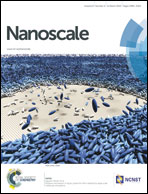Hierarchical nanostructured NiCo2O4 as an efficient bifunctional non-precious metal catalyst for rechargeable zinc–air batteries†
Abstract
A nickel-doped cobalt oxide spinel structure is a promising non-precious metal electrocatalyst for oxygen evolution and oxygen reduction in rechargeable metal–air batteries and water electrolyzers operating with alkaline electrolytes. One dimensional NiCo2O4 (NCO) nanostructures were prepared by using a simple electrospinning technique with two different metal precursors (metal nitrate/PAN and metal acetylacetonate/PAN). The effect of precursor concentration on the morphologies was investigated. Single-phase, NCO with an average diameter of 100 nm, porous interconnected fibrous morphology was revealed by FESEM and FETEM analysis. The hierarchical nanostructured 1D-spinel NiCo2O4 materials showed a remarkable electrocatalytic activity towards oxygen reduction and evolution in an aqueous alkaline medium. The extraordinary bi-functional catalytic activity towards both ORR and OER was observed by the low over potential (0.84 V), which is better than that of noble metal catalysts [Pt/C (1.16 V), Ru/C (1.01 V) and Ir/C (0.92 V)], making them promising cathode materials for metal–air batteries. Furthermore, the rechargeable zinc–air battery with NCO-A1 as a bifunctional electrocatalyst displays high activity and stability during battery discharge, charge, and cycling processes.


 Please wait while we load your content...
Please wait while we load your content...